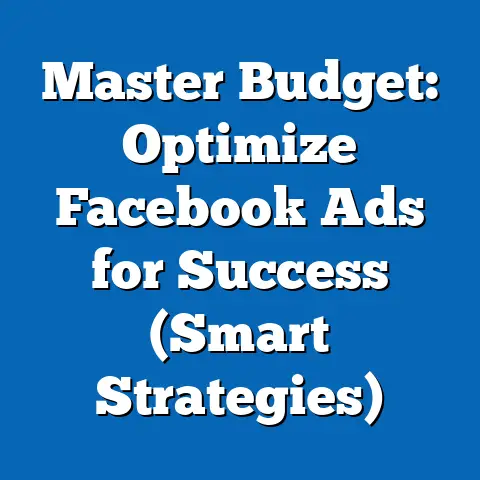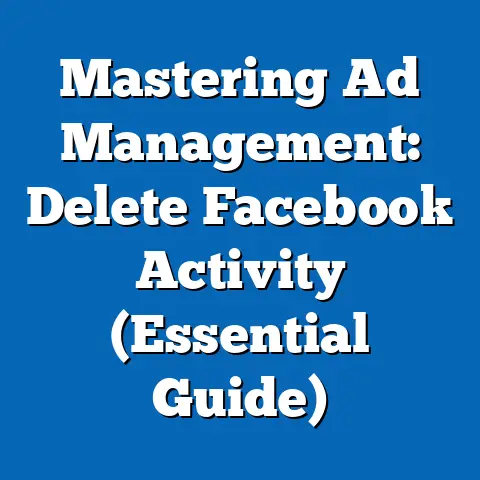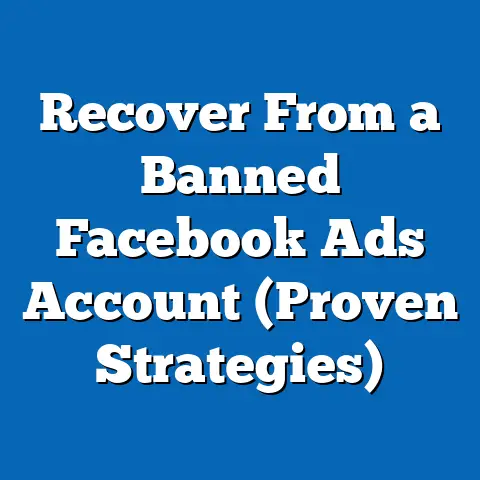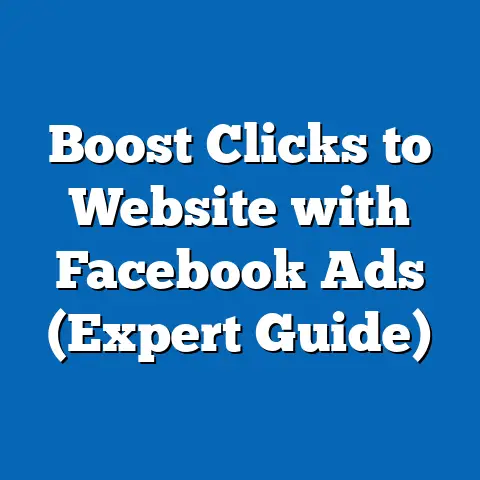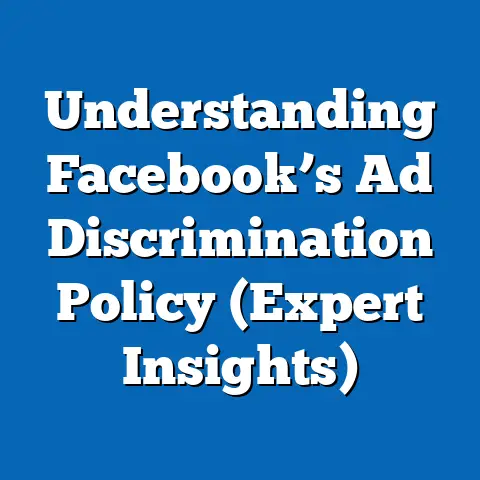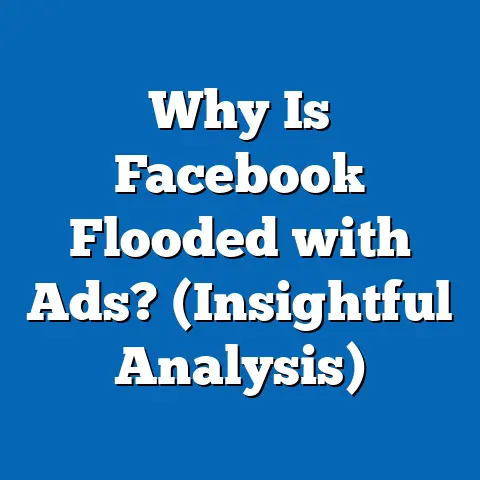Elevate Wine Ads on Facebook (Proven Strategies)
In the dynamic world of digital marketing, every dollar counts, especially when you’re navigating the competitive landscape of the wine industry. I’ve seen firsthand how a well-executed Facebook advertising strategy can be a game-changer, transforming not just brand visibility, but also delivering a substantial return on investment. Forget simply throwing money at ads and hoping for the best. We need to think strategically, creatively, and analytically.
The wine market is saturated. Wineries and retailers alike are vying for consumer attention. Standing out requires more than just a great product; it demands smart marketing. That’s where Facebook advertising comes in. It’s not just about posting pretty pictures of vineyards; it’s about understanding the platform’s capabilities, crafting compelling content, targeting the right audience, and meticulously measuring your results.
1: Understanding the Facebook Advertising Ecosystem
Before diving into the creative aspects of ad creation, it’s crucial to understand the fundamental components of Facebook’s advertising platform. Think of it as familiarizing yourself with the tools in your winemaking cellar before crafting the perfect vintage.
- Targeting Options: Facebook boasts incredibly granular targeting capabilities. You can reach users based on demographics (age, location, gender), interests (wine enthusiasts, foodies, travel lovers), behaviors (purchase history, device usage), and connections (friends of people who like your page). I once worked with a small winery that significantly increased their online sales by targeting users in specific zip codes with an interest in organic wines. The key is to be as specific as possible to reach the people most likely to be interested in your product.
- Ad Formats: Facebook offers a variety of ad formats, including single image ads, video ads, carousel ads (allowing you to showcase multiple products or features), collection ads (ideal for showcasing a range of wines in a visually appealing format), and lead generation ads (perfect for collecting email addresses and building your subscriber list). The best format depends on your campaign goals and the type of story you want to tell.
- Analytics Tools: Facebook Ads Manager provides a wealth of data and insights into your ad performance. You can track metrics like reach, impressions, clicks, conversions, cost per click (CPC), and return on ad spend (ROAS). This data is invaluable for optimizing your campaigns and ensuring you’re getting the most bang for your buck. I always tell my clients, “What gets measured, gets managed.”
The Algorithm’s Influence
Facebook’s algorithm plays a significant role in determining which ads are shown to which users. The algorithm prioritizes ads that are relevant, engaging, and of high quality. For wine-related content, this means focusing on creating ads that resonate with your target audience and that adhere to Facebook’s advertising policies (particularly regarding alcohol advertising). Facebook’s algorithm changes frequently, so it’s essential to stay updated on the latest best practices to ensure your ads are seen by the right people.
Takeaway: Understanding the Facebook advertising ecosystem is the foundation for successful wine advertising. Familiarize yourself with the targeting options, ad formats, and analytics tools to create effective and data-driven campaigns.
2: Crafting Compelling Ad Content
The heart of any successful Facebook ad campaign lies in its content. You can have the best targeting in the world, but if your ad copy falls flat, you won’t get the results you’re looking for. Think of your ad copy as the voice of your wine – it needs to be captivating, informative, and persuasive.
- Headlines: Your headline is the first thing people see, so it needs to grab their attention immediately. Use strong verbs, intriguing questions, or compelling offers to entice users to click. For example, instead of a generic headline like “New Wine Available,” try something like “Discover Your New Favorite Summer Rosé” or “Uncork the Taste of [Region]’s Best Cabernet Sauvignon.”
- Body Text: Your body text should provide more detail about your wine and its unique qualities. Focus on the benefits of drinking your wine, rather than just listing its features. For example, instead of saying “Our Chardonnay is aged in oak barrels,” try “Experience the rich, buttery notes of our Chardonnay, aged in oak barrels for a smooth, elegant finish.”
- Calls to Action (CTAs): Your CTA tells users what you want them to do next. Use clear and concise CTAs like “Shop Now,” “Learn More,” “Order Online,” or “Visit Our Tasting Room.” Make sure your CTA is visually prominent and easy to click.
The Power of Storytelling
Wine is more than just a beverage; it’s an experience. It’s about the history, the tradition, the passion, and the people behind the bottle. Storytelling can be a powerful tool for connecting with your audience on an emotional level. Share the story of your vineyard, the challenges you’ve overcome, and the unique qualities that make your wine special.
I remember working with a family-owned winery that struggled to compete with larger brands. We decided to focus on their story – the generations of winemakers, the sustainable farming practices, and the unwavering commitment to quality. We created a series of Facebook ads that told their story through compelling visuals and heartfelt copy. The response was incredible. Customers felt a connection to the winery and were eager to support a brand that shared their values.
Successful Wine Ad Examples:
- Imagery + Value Proposition: An ad for a wine subscription service featured a stunning photo of a curated selection of wines, paired with the headline “Discover Hand-Picked Wines Delivered to Your Door.” The clear value proposition and enticing visuals drove high click-through rates.
- Behind-the-Scenes + Promotion: A video ad from a winery showed the winemaking process from grape to bottle, set to upbeat music. The ad ended with a limited-time discount code, creating a sense of urgency and encouraging immediate purchase.
- User-Generated Content + Community: An ad featured a customer testimonial and a photo of them enjoying the wine. This social proof resonated strongly with potential customers and built a sense of community around the brand.
Takeaway: Crafting compelling ad content is essential for capturing attention and driving engagement. Use strong headlines, persuasive body text, and clear CTAs. Leverage the power of storytelling to connect with your audience on an emotional level.
3: Visual Appeal: The Role of Imagery and Video
In the fast-paced world of social media, visuals are king. High-quality imagery and video are crucial for capturing attention and conveying the essence of your wine brand. Think of your visuals as the artwork on your wine label – they need to be visually appealing and representative of the quality of the product inside.
- High-Quality Visuals: Use professional-grade photography and videography to showcase your wine in the best possible light. Avoid using blurry, pixelated, or poorly lit images. Invest in professional equipment or hire a photographer/videographer with experience in the food and beverage industry.
- Ad Formats: Facebook offers a variety of ad formats that can be used effectively for wine promotions:
- Single Image Ads: Ideal for showcasing a single bottle of wine or a specific tasting note.
- Video Ads: Perfect for telling your brand story, showcasing the winemaking process, or featuring customer testimonials.
- Carousel Ads: Allow you to showcase multiple wines or highlight different aspects of a single wine (e.g., tasting notes, food pairings, production process).
- Collection Ads: Designed for mobile users, collection ads feature a main image or video above a selection of related products. This format is ideal for showcasing a range of wines in a visually appealing and easily shoppable format.
- Single Image Ads: Ideal for showcasing a single bottle of wine or a specific tasting note.
- Video Ads: Perfect for telling your brand story, showcasing the winemaking process, or featuring customer testimonials.
- Carousel Ads: Allow you to showcase multiple wines or highlight different aspects of a single wine (e.g., tasting notes, food pairings, production process).
- Collection Ads: Designed for mobile users, collection ads feature a main image or video above a selection of related products. This format is ideal for showcasing a range of wines in a visually appealing and easily shoppable format.
Lifestyle Imagery and Behind-the-Scenes Footage
Lifestyle imagery can help you connect with your target audience on an emotional level. Show people enjoying your wine in various settings – at a dinner party, on a picnic, or by the fireplace. This helps users visualize themselves enjoying your wine and makes it more appealing.
Behind-the-scenes footage can give your audience a glimpse into the winemaking process and the people behind the brand. This can help build trust and transparency and make your wine more relatable.
Tips for Creating Visually Appealing Content:
- Use natural light: Natural light is always the best option for photographing wine.
- Focus on the details: Highlight the color, texture, and clarity of your wine.
- Use props: Use props like wine glasses, cheese boards, and flowers to create a visually appealing scene.
- Keep it simple: Avoid cluttering your visuals with too many elements.
- Be consistent: Use a consistent visual style across all your ads to build brand recognition.
Takeaway: High-quality visuals are essential for capturing attention and conveying the essence of your wine brand. Use professional-grade photography and videography, and experiment with different ad formats to find what works best for your target audience.
4: Targeting and Retargeting Strategies
Targeting and retargeting are the secret weapons of successful Facebook advertising. They allow you to reach the right people with the right message at the right time. Think of targeting as casting a wide net to capture potential customers, and retargeting as reeling in those who have already shown interest.
-
Precise Targeting: Facebook’s granular targeting options allow you to reach users based on a wide range of criteria, including:
- Lookalike Audiences: Create audiences that are similar to your existing customers or website visitors. This is a great way to reach new potential customers who are likely to be interested in your wine.
- Interest-Based Targeting: Target users based on their interests, such as wine, food, travel, or specific wine regions.
- Geographic Targeting: Target users in specific locations, such as cities, states, or zip codes. This is particularly useful for promoting events or tastings at your winery.
-
Retargeting Campaigns: Retargeting allows you to show ads to users who have previously interacted with your brand or visited your website. This is a highly effective way to re-engage potential customers and drive conversions. For example, you can retarget users who have:
- Visited your website but didn’t make a purchase.
- Added a wine to their cart but didn’t complete the checkout process.
- Watched a video on your Facebook page.
- Engaged with your previous Facebook ads.
Precise Targeting: Facebook’s granular targeting options allow you to reach users based on a wide range of criteria, including:
- Lookalike Audiences: Create audiences that are similar to your existing customers or website visitors. This is a great way to reach new potential customers who are likely to be interested in your wine.
- Interest-Based Targeting: Target users based on their interests, such as wine, food, travel, or specific wine regions.
- Geographic Targeting: Target users in specific locations, such as cities, states, or zip codes. This is particularly useful for promoting events or tastings at your winery.
Retargeting Campaigns: Retargeting allows you to show ads to users who have previously interacted with your brand or visited your website. This is a highly effective way to re-engage potential customers and drive conversions. For example, you can retarget users who have:
- Visited your website but didn’t make a purchase.
- Added a wine to their cart but didn’t complete the checkout process.
- Watched a video on your Facebook page.
- Engaged with your previous Facebook ads.
Case Studies in Targeting Success:
- Local Restaurant & Wine Pairing: A local restaurant partnered with a winery to run a Facebook ad campaign promoting a special wine pairing dinner. They targeted users within a 10-mile radius of the restaurant who had an interest in both wine and fine dining. The campaign resulted in a sold-out event and increased brand awareness for both the restaurant and the winery.
- E-Commerce Wine Retailer: An e-commerce wine retailer used retargeting to show ads to users who had abandoned their carts. The ads featured a discount code and free shipping, which incentivized users to complete their purchase. The retargeting campaign resulted in a significant increase in sales and a higher conversion rate.
- Winery Tasting Event: A winery promoted a tasting event by targeting users who had previously visited their website or engaged with their Facebook page. The ads featured photos of the winery, information about the event, and a link to purchase tickets. The campaign resulted in a high attendance rate and increased brand loyalty.
Takeaway: Precise targeting and retargeting are essential for maximizing ad reach and effectiveness. Use Facebook’s granular targeting options to reach the right people with the right message at the right time. Implement retargeting campaigns to re-engage potential customers and drive conversions.
5: Measuring Success: Analyzing Ad Performance
You’ve created compelling ads, targeted the right audience, and launched your Facebook campaign. Now what? It’s time to measure your success and analyze your ad performance. Think of this as tasting your wine and making adjustments to the blend to achieve the perfect flavor.
-
Key Performance Indicators (KPIs): Focus on the KPIs that are most relevant to your business goals. Some common KPIs for Facebook ads in the wine industry include:
- Click-Through Rate (CTR): The percentage of users who click on your ad after seeing it. A high CTR indicates that your ad is relevant and engaging.
- Conversion Rate: The percentage of users who take a desired action after clicking on your ad, such as making a purchase, signing up for an email list, or visiting your tasting room.
- Return on Ad Spend (ROAS): The amount of revenue generated for every dollar spent on advertising. A high ROAS indicates that your ad campaign is profitable.
- Cost Per Click (CPC): The amount you pay each time someone clicks on your ad.
- Cost Per Acquisition (CPA): The amount you pay to acquire a new customer through your ad campaign.
-
Facebook Ads Manager: Use Facebook’s Ads Manager to track and analyze your ad performance. Ads Manager provides a wealth of data and insights into your ad campaigns, including:
- Reach and Impressions: The number of people who saw your ad and the number of times your ad was displayed.
- Website Traffic: The number of users who visited your website after clicking on your ad.
- Conversions: The number of users who took a desired action after clicking on your ad.
- Demographics: The age, gender, and location of the users who saw and interacted with your ad.
Key Performance Indicators (KPIs): Focus on the KPIs that are most relevant to your business goals. Some common KPIs for Facebook ads in the wine industry include:
- Click-Through Rate (CTR): The percentage of users who click on your ad after seeing it. A high CTR indicates that your ad is relevant and engaging.
- Conversion Rate: The percentage of users who take a desired action after clicking on your ad, such as making a purchase, signing up for an email list, or visiting your tasting room.
- Return on Ad Spend (ROAS): The amount of revenue generated for every dollar spent on advertising. A high ROAS indicates that your ad campaign is profitable.
- Cost Per Click (CPC): The amount you pay each time someone clicks on your ad.
- Cost Per Acquisition (CPA): The amount you pay to acquire a new customer through your ad campaign.
Facebook Ads Manager: Use Facebook’s Ads Manager to track and analyze your ad performance. Ads Manager provides a wealth of data and insights into your ad campaigns, including:
- Reach and Impressions: The number of people who saw your ad and the number of times your ad was displayed.
- Website Traffic: The number of users who visited your website after clicking on your ad.
- Conversions: The number of users who took a desired action after clicking on your ad.
- Demographics: The age, gender, and location of the users who saw and interacted with your ad.
Interpreting the Data:
Analyzing your ad performance data can provide valuable insights into what’s working and what’s not. For example, if you have a low CTR, it may indicate that your ad copy or visuals are not engaging enough. If you have a low conversion rate, it may indicate that your landing page is not optimized for conversions.
I once helped a winery struggling with low online sales. After analyzing their Facebook ad performance data, we discovered that their ads were driving a lot of traffic to their website, but very few users were making a purchase. We realized that their website was not mobile-friendly and that the checkout process was too complicated. We redesigned their website and simplified the checkout process, which resulted in a significant increase in online sales.
Takeaway: Measuring success and analyzing ad performance is crucial for optimizing your Facebook ad campaigns. Track the KPIs that are most relevant to your business goals, and use Facebook Ads Manager to gain insights into what’s working and what’s not.
Conclusion
Elevating your wine ads on Facebook requires a strategic, creative, and analytical approach. By understanding the Facebook advertising ecosystem, crafting compelling ad content, using high-quality visuals, mastering targeting and retargeting strategies, and meticulously measuring your results, you can unlock the full potential of Facebook advertising and drive sales, boost customer engagement, and build brand recognition.
Don’t be afraid to experiment, test different approaches, and learn from your mistakes. The key is to stay adaptable, stay updated on the latest Facebook advertising best practices, and never stop striving to improve your campaigns.
Facebook advertising has the power to transform the way wineries and retailers engage with customers. It’s not just about selling wine; it’s about building relationships, sharing stories, and creating a community of wine lovers. By implementing these proven strategies, you can connect with your target audience in a meaningful way and elevate your wine brand to new heights. Now, go forth and uncork the power of Facebook advertising!

